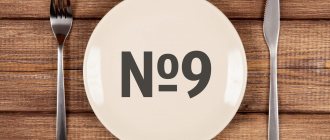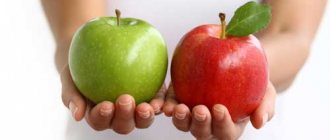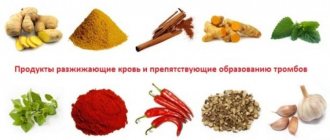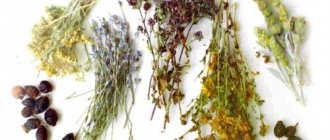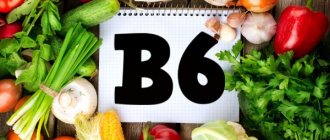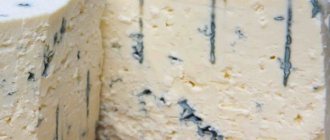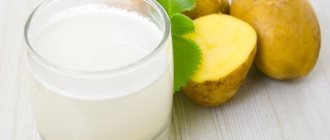Diabetes is a dangerous disease that can lead to very serious negative consequences. It is important for a person suffering from this disease not only to undergo treatment, but to lead a healthy lifestyle and follow a diet. The disease can develop in an elderly person, a young person, and even a child. Despite the fact that the disease is serious, with constant monitoring, proper treatment, and proper nutrition, you can live long and happily with this disease. To normalize blood sugar, normalize well-being and eliminate unpleasant symptoms, it is important to know which foods can be consumed if you have diabetes and which ones cannot.
Healthy foods
There are many useful products that will be useful for endocrinological patients. Food products for diabetics are no different from regular foods, except for the reduced amount of carbohydrate component in the composition. And despite the prevailing opinion that healthy food is tasteless and lacks variety, it is worth at least familiarizing yourself with the list of products for diabetes. Healthy and wholesome food is the key to longevity and well-being! The list of products includes all the basic chemical elements necessary for the full functioning of organs and systems.
Vegetables
Vegetables that contain little carbohydrate component will be useful. Ideal vegetables for people suffering from such a serious disease include:
- All varieties of cabbage, especially white cabbage.
- Zucchini, eggplant and similar products.
- Cucumbers.
- Potato.
- Tomatoes.
- Any types of greens and salad.
Endocrinologists note that in case of diabetes mellitus, fresh tomatoes and cucumbers can be consumed in unlimited quantities, since they do not at all affect carbohydrate metabolism in the body. It is worth noting that vegetables are best consumed fresh, boiled or steamed. For any type of diabetes, it is not recommended to eat pickled and salted vegetables, as they slow down metabolic processes in the body and contribute to fluid stagnation.
Fruits and berries
There are many tasty and healthy fruits that are not only not contraindicated for diabetics, but, on the contrary, are recommended for consumption. Recommended fruits and berries:
Foods prohibited for type 2 diabetes + table
- Apples are green and red.
- Persimmon.
- Plum.
- Gooseberry.
- Currants of different varieties.
- Cranberry.
Some fruits, such as apples, are rich in fiber, which helps to achieve a feeling of satiety quite quickly, but fiber is not digested in the gastrointestinal tract and passes through the body in transit, which helps improve intestinal motility and peristalsis, and also helps to lose excess weight. For people suffering from diabetes, exclusively sweet fruits such as bananas, figs, any dried fruits and watermelons are contraindicated.
Flour products
People with diabetes do not have to completely exclude bread products from their diet. You can and should eat rye bread or with bran, but wheat bread and baked goods should be excluded from the diet.
Meat and fish
Turkey and rabbit meat have proven themselves to be excellent in any type of diet therapy, especially for diabetics. Lean varieties of meat and fish allow the body to receive all the necessary nutrients and essential amino acids, which are so necessary for anabolic processes in the body. It is best to eat meat boiled or stewed and it is advisable to completely avoid frying meat in oil.
Excluded from the diet: goose meat, duck, any sausages and semi-finished products, canned food and offal. In principle, there is little benefit from such products not only for the sick, but also for a healthy person, but there is a lot of harm, ranging from trans fats to the lack of balance of basic nutrients - proteins, fats and carbohydrates.
Dairy
Which dairy products are best for diabetic patients is a rather complicated question. Eating low-fat fermented milk products definitely has a good effect on metabolic activity. For patients with diabetes mellitus, any fatty milk drinks and cream are contraindicated, as they lead to an increase in blood cholesterol and low-density lipoproteins, which harm the vascular wall. A complete list of healthy dairy products can be found on the Internet.
Table of foods that are good for diabetics in the form of a pyramidal hierarchical diagram
Low-carb diet for stage 2 diabetics
A low-carbohydrate diet is effective for obese diabetics. The results of her study showed that if a diabetic patient consumes no more than 20 g of carbohydrates per day, then within six months he will have low sugar levels and will be able to completely stop taking medications. This diet is suitable for people with an active lifestyle. After just two weeks, a diabetic patient’s blood pressure and lipid profile improve. The most popular low-carb diets:
- Mayo Clinic
The main product of the Mayo diet for patients with type 2 diabetes is fat-burning soup. It is prepared from six onions, a couple of tomatoes and green bell peppers, a small head of cabbage, a bunch of stalk celery and two cubes of vegetable broth. This soup must be seasoned with hot pepper (chili or cayenne), due to which it burns fat. You can eat it in unlimited quantities, adding fruit to every meal.
- South Beach
The main goal of this diet is to control the feeling of hunger in a patient with type 2 diabetes mellitus, reduce weight, maintaining it at a normal level throughout life. At the first stage of such nutrition, there are very strict restrictions: you are allowed to eat proteins and strictly defined vegetables. At the second stage of a low-carbohydrate diet, when weight decreases, other foods are introduced: fruits, fermented milk, lean meat, complex carbohydrates. This diet is more popular among type 2 diabetics.
- Glycemic diet
The proposed diet helps patients with type 2 diabetes avoid sudden changes in insulin levels. It is based on a strict rule: 40% of the body's calories come from unprocessed complex carbohydrates. Therefore, juices are replaced with fresh fruits, white bread is replaced with whole grains, and so on. 30% of calories in the body should come from fat, so the weekly diet of a type 2 diabetic includes daily lean pork, fish, and chicken. 30% of your diet should come from low-fat dairy products.
Table for calculating the required amount of carbohydrates
To make it easier to eat if type 2 diabetes occurs, experts have developed a special table for calculating the required amount of carbohydrates. In laboratories, various products were studied for carbohydrate content, and in order to convey the results of the research to people far from science, a special bread unit of measurement (XU) was invented.
It compares foods based on carbohydrate content rather than calorie content. Conventionally, XE contains 12-15 g of carbohydrates, and it is convenient to measure various products in it - from watermelons to sweet cheesecakes. Calculating bread units for a diabetic patient is simple: on the factory packaging of the product, as a rule, the amount of carbohydrates per 100 g is indicated, which is divided by 12 and adjusted by weight.
To calculate XE in home cooking, a diabetic patient needs a calculator, a recipe and a XE table. So, for example, if 9 tbsp were used for 10 pancakes. l. flour (1 tbsp - 1XE), 1 glass of milk (1XE), 1 chicken egg (no XE) and 1 tbsp. vegetable oil (no XE), then one pancake is one XE. Diabetics over 50 years of age are allowed to consume 12-14 XE per day, with diabetes mellitus and obesity degree 2A - no more than 10 XE, and with diabetes mellitus and obesity degree 2B - no more than 8 XE.
Table of bread units
1XE is found in the following products:
- 25 g of any bread;
- 1 tbsp. l. flour, starch, crackers;
- 2 tbsp. l. boiled cereals;
- 1 tbsp. l. Sahara;
- 3 tbsp. l. boiled pasta;
- 35 g fried potatoes;
- 75 g mashed potatoes;
- 7 tbsp. l. any legumes;
- 1 medium beet;
- 1 saucer of cherries or strawberries;
- 70 g grapes;
- 8 tbsp. currants, raspberries, gooseberries.
- 3 pcs. carrots;
- 70 g banana or grapefruit;
- 150 g plums, apricots or tangerines;
- 250 ml kvass;
- 140 g pineapple;
- 270 g watermelon;
- 100 g melon;
- 200 ml beer;
- 1/3 tbsp. grape juice;
- 1 tbsp. dry wine;
- ½ cup apple juice;
- 1 tbsp. low-fat dairy products;
- 65 g ice cream.
Diet for diabetes
This does not mean that diabetics should severely restrict their diet. There is a large list of foods that are suitable for their diet. First of all, the menu must include meat, but only low-fat varieties, it can be chicken, turkey or veal. For fish, preference should be given to cod or pike perch, with a low fat content.
It is advisable that the diet of patients with diabetes include various dairy products, but only with a small percentage of fat. You can eat eggs, but only no more than 2 eggs per day; It is useful to eat quail eggs.
Among cereals, preference should be given to buckwheat, millet and pearl barley; they can be added to soups or made into porridge. Pasta can also be included in the menu, but only in limited quantities. It is better to replace bread made from wheat flour with rye flour or with the addition of bran.
It is very beneficial to eat vegetables, especially those high in fiber, such as beans, zucchini, cabbage and eggplant. It is better to boil or bake potatoes. It is preferable to eat fruits and berries of sour varieties, for example: apples, cherries, currants, plums and pears. All citrus fruits are very healthy, and they also contain vitamin C. Grapefruit ranks first among them in terms of beneficial properties.
When preparing dishes, be sure to add herbs, for example: parsley, dill, green onions. Among the spices you can add ginger and bay leaf to dishes: they will give the dishes a more interesting taste. And from a bay leaf you can prepare a healing infusion that will reduce the sugar content: 5 leaves are poured into a glass of boiling water and infused in a thermos. A day later, the finished infusion is drunk per day in 3 doses.
It is very useful to eat pumpkin seeds: they contain trace elements and vitamins that are rich in unsaturated fatty acids. Sunflower seeds can also be eaten, but in small quantities. The consumption of nuts is also limited; among them you should choose peanuts, walnuts, pine nuts, and almonds.
Among confectionery products, preference is given to products that contain fructose instead of sugar. In stores they are located on separate shelves intended for. But you shouldn't abuse them. The diet necessarily includes various drinks, including juices, compotes and jelly made from sour varieties of fruits and berries.
You can drink tea or rosehip decoction, but instead of sugar, sweeteners are added to them. Coffee should be replaced with chicory: it does not contain caffeine and is very useful for diabetes, because lowers blood sugar levels and significantly improves the functioning of all internal organs.
Allowed foods and those that can be consumed rarely
When eating for diabetes, permitted foods are a group that can be consumed without restrictions.
| Low GI: | Average GI: |
|
|
| Products with borderline GI content should be significantly limited and, in case of severe diabetes, excluded: | |
|
Signs of diabetes
Diabetes may not make itself felt for a long time. And a person learns about the disease by chance, at the next preventive examination. But there is a list of symptoms that indicate that the process has started and diabetes has become a part of a person’s life. This:
- uncontrollable thirst;
- frequent urination;
- chronic fatigue;
- active weight loss;
- decreased sexual activity;
- regular dizziness;
- heaviness in the legs;
- loss of visual acuity;
- cramps and numbness of the limbs;
- poor tissue regeneration;
- frequent infectious diseases;
- skin itching;
- low body temperature.
Diabetes is characterized by pain in the heart area, the development of hepatosis (fatty liver cells) and cirrhosis (replacement of liver cells with connective tissue cells).
Summary table of glycemic index and calorie content of foods
Be disciplined - eat only the foods planned in the weekly menu.
What you need to pay attention to when calculating the daily and weekly menu:
- When creating a diet, you need to look not only at the permitted and prohibited foods for diabetes, but also monitor the balance of proteins, quantity and quality of fats.
- In addition, with the discovery of the glycemic index (GI), foods useful and harmful for diabetes are assessed from this point of view - the higher the GI index, the higher the level of glucose in the blood will be, during and after its fermentation. It is ideal if a diabetic uses only products with a low and medium index - no higher than 50 units.
- Moreover, the previously recommended “1800 kcal” diet is no longer relevant today. Diabetics are recommended to adjust this figure according to the planned physical activity. It has been proven that sudden weight loss turns into an equally rapid weight gain. Therefore, we must adhere to this ratio - daily food calorie content should be 200-400 kcal less than total energy costs. Extra pounds will be lost slowly, but irrevocably.
- If your finished food products contain, or you want to take separately, substances such as polyols - sorbitol, mannitol, erythritol, xylitol and D-tagatose, or hydrated disaccharides - isomalt, maltitol, lactitol and ottalose, you should carefully consider the dosage. Despite their low calorie content - an average of 2 kcal / g, daily intake of 20 g will cause diarrhea and additional dehydration of the body.
- Remember that consuming whole grain cereals will not significantly improve glycemic parameters in people with type 2 diabetes, but they will reduce the level of systemic inflammation.
- Ensure adequate fiber intake—14 grams per 1,000 calories, or an average of 25 grams for women and 38 grams for men.
- Note. Taking 2 tablespoons of plant phytosterols found in legumes daily is an excellent cardioprotective diet. This, but not more (!), amount of legumes can effectively block the absorption of dietary and bile cholesterol from the gastrointestinal tract, and lower the level of low-density lipoproteins (LDL).
- Maintain a 1:1 ratio of protein from plant to animal sources. At the same time, diabetics with kidney disease are recommended to consume 0.8 g per 1 kg of body weight, and all other type 2 diabetics - 1.2 g per 1 kg of not actual, but ideal (!) body weight.
- Table salt intake should be reduced to 2300 mg/day, and diabetics with hypertension should not go beyond 1500 mg/day.
Questions and answers
Is it possible to eat nuts, beets, rice, persimmons, pomegranates and pumpkin if you have diabetes?
Rice should not be consumed. Nuts (walnuts, peanuts, almonds, pine nuts) - possible, but in limited quantities (up to 50 grams per day), previously cleared of shells and other elements. You can eat beets for diabetes in boiled form, using them, for example, as a component of vinaigrette - no more than 100 grams per day.
Persimmon is a product with a high glycemic index, but it contains a huge amount of useful substances and does not have such a significant effect on sugar levels, since it contains mainly fructose. It can be consumed, but in strictly limited quantities, no more than one fruit every few days.
Pumpkin is included in the “green list” for diabetes and can be consumed without special restrictions (the only threshold is the total calorie content of the menu). Pomegranate can be consumed by type 2 diabetics, no more than 50 grams/day.
Is it possible to consume honey if you have diabetes?
Until the 90s of the twentieth century, nutritionists classified honey as an absolutely prohibited type of food for diabetes of any type. Recent studies show that a small amount of honey (5–7 grams per day) does not cause diabetes in type 2 diabetics due to the presence of large amounts of fructose in honey. Therefore, it can be consumed, but in limited quantities.
How much fruit can you eat if you have this disease?
Use them in moderation, carefully choosing fruits for your diet - for example, grapes are absolutely contraindicated for you, while apples, oranges or persimmons can be included in the diet, naturally in limited quantities - no more than 1-2 fruits per day.
Is there a low-carb diet for type 2 diabetes?
Low-water diets are specifically intended for diabetics with type 2 diabetes who have problems with excess weight. Its basic direction is to reduce the consumption of carbohydrates and reduce the total daily energy value of the diet. As an alternative, modern nutritionists often offer vegetarian diets - in some cases they are even more effective than the classic therapeutic nutritional diet usually recommended by doctors.
Do I need to follow a diet?
This is a necessary condition for supporting compensation of carbohydrate metabolism. A 6-fold nutritional plan with a maximum total daily energy threshold of 2400 kcal for adults is the optimal option used everywhere.
Is a strict diet necessary for diabetes?
Modern science has significantly expanded the boundaries of permitted foods for diabetes, which has allowed patients to diversify their daily diet. The entire rigor of the diet lies in calculating the amount of carbohydrates consumed, as well as the total calorie content and frequency of meals, while individual components of the diet are subject to equivalent replacement within their groups.
The child was born with diabetes. How to feed him?
It is not entirely clear what kind of diabetes we are talking about. If your child has been diagnosed with neonatal transient diabetes, it is treatable and, as a rule, the child can be rid of it forever. If we are talking about permanent neonatal diabetes, then the baby will need insulin all his life and, accordingly, lifelong therapy. Both types of the disease are quite rare and are a genetic abnormality, sometimes leading to type 1 diabetes in the future.
General tips and tricks
Diabetics are given certain recommendations regarding nutrition, the schedule of food intake into the body, helping to maintain glucose in the blood, preventing the aggravation of the clinical picture as a whole.
It is important to reduce the consumption of foods rich in easily digestible carbohydrates. If you are overweight, you need to reduce your calorie intake per day, ideally to 2000 kilocalories
Calorie content may vary depending on the patient's physical activity.
Due to the restriction of many foods in the diet, the patient should additionally take vitamin or mineral complexes to compensate for the deficiency of essential substances for normal functioning.
Type 2 diabetes requires certain dietary changes:
- Reducing calories while maintaining the energy value of food for the body.
- The energy value must equal the amount of energy expended.
- To normalize metabolic processes, it is recommended to eat at the same time.
- In addition to main meals, you need to have snacks to prevent feelings of hunger and a possible breakdown in overeating.
- In the second half of the day, the intake of carbohydrates is reduced to a minimum.
- To quickly get enough, the menu includes as many vegetables and fruits as possible, rich in dietary fiber (choose food from the list of allowed foods).
- To remove excess fluid from the body, reduce salt intake to 4 grams per day.
- When choosing bakery products, it is recommended to choose products made from rye flour with the addition of bran.
A balanced diet helps to neutralize the negative symptoms of a hyperglycemic state, helps reduce glucose levels and improve overall well-being. And also, getting rid of bad eating habits normalizes metabolic processes in the body.
It is necessary to focus on fruits, vegetables, dairy and fermented milk products, and lean meat. . After all, the absolute exclusion of glucose as the only source of energy means rapid depletion of natural energy reserves
After all, the absolute exclusion of glucose as the only source of energy means a rapid depletion of natural energy reserves.
Sweeteners
This issue remains controversial, since diabetic patients do not feel an urgent need for them, but use them only to satisfy their taste preferences and habit of adding sugar to dishes and drinks. In principle, there are no artificial and natural sugar substitutes with 100% proven safety. The main requirement for them is no increase in blood sugar or a slight increase in the indicator.
Currently, with strict blood sugar control, 50% fructose, stevia and honey can be used as sweeteners.
Stevia
Stevia is a zero-calorie, sugar-replacement supplement made from the leaves of the perennial stevia plant. The plant synthesizes sweet glycosides, such as stevioside, a substance that gives the leaves and stems a sweet taste, 20 times sweeter than regular sugar. Can be added to prepared dishes or used in cooking. It is believed that stevia helps restore the pancreas and helps produce its own insulin without affecting blood sugar.
Officially approved as a sweetener by WHO experts in 2004. The daily norm is up to 2.4 mg/kg (no more than 1 tablespoon per day). If the supplement is abused, toxic effects and allergic reactions may develop. Available in the form of powder, liquid extracts and concentrated syrups.
Fructose
Fructose 50%. Fructose does not require insulin to metabolize, so it is safe in this regard. It has 2 times less calories and 1.5 times more sweetness compared to regular sugar. It has a low GI (19) and does not cause a rapid increase in blood sugar.
The consumption rate is no more than 30-40 grams. per day. When consuming more than 50 g. fructose per day decreases the liver's sensitivity to insulin. Available in powder and tablet form.
What not to eat if you have type 2 diabetes
- All bakery products and cereals not listed in the table;
- Cookies, marshmallows, marshmallows and other confectionery products, cakes, pastries, etc.;
- Honey, unspecified chocolate, sweets, naturally white sugar;
- Potatoes, carbohydrate-breaded fried vegetables, most root vegetables, except those noted above;
- Store-bought mayonnaise, ketchup, frying into soup with flour and all sauces based on it;
- Condensed milk, store-bought ice cream (any kind!), store-bought complex products labeled “milk”, because... these are hidden sugars and trans fats;
- Fruits and berries with high GI: banana, grapes, cherries, pineapple, peaches, watermelon, melon, pineapple;
- Dried fruits and candied fruits: figs, dried apricots, dates, raisins;
- Store-bought sausages, sausages, etc., containing starch, cellulose and sugar;
- Sunflower and corn oil, any refined oils, margarine;
- Large fish, canned food in oil, smoked fish and seafood, dry salty snacks, popular with beer.
Don’t rush to dismiss your diet because of strict restrictions!
Yes, it's unusual. Yes, no bread at all. And you can’t even eat buckwheat at the first stage. And then they offer to get acquainted with new cereals and legumes. And they encourage you to delve into the composition of the products. And the oils listed are strange. And an unusual principle - “you can eat fats, look for healthy ones”... Complete bewilderment, but how to live on such a diet?!
Live well and long! The proposed nutrition will work for you within a month.
Bonus: you will eat many times better than your peers who have not yet been affected by diabetes, will have grandchildren and will increase your chances of active longevity.
Understand that type 2 diabetes should not be underestimated. Many people have risk factors for this disease (among them our sweet and starchy diet, with bad fats and lack of protein). But the disease most often occurs in mature and elderly people, when other weak points have already formed in the body.
If left unchecked, diabetes will actually shorten your life and kill you before it expires. It attacks all blood vessels, heart, liver, will not allow you to lose weight and will critically worsen your quality of life. Decide to limit carbohydrates to a minimum! The result will please you.
Basic rules of nutrition for diabetes
Nutrition for diabetes should comply with the principles of restoring carbohydrate metabolism. Products included in the patient’s diet should not place increased stress on the pancreas, the organ responsible for the synthesis of insulin. Patients with this diagnosis should avoid large meals. A single serving should not exceed 200-250 g (plus 100 ml of drink).
Note! It is important to control not only the amount of food you eat, but also the volume of liquid you drink. A standard cup holds about 200-230 ml of tea
People with diabetes are allowed to drink half this amount at a time. If the meal consists only of drinking tea, you can leave the usual amount of drink.
It is best to eat at the same time every day. This will improve metabolic processes and digestion, since gastric juice, containing digestive enzymes for the breakdown and absorption of food, will be produced at certain hours.
Principles of nutrition for diabetes
When creating a menu, you should adhere to other recommendations of experts, namely:
- when choosing a method of heat treatment of products, preference should be given to baking, boiling, stewing and steaming;
- the intake of carbohydrates should be uniform throughout the day;
- the bulk of the diet should consist of protein foods, vegetables and greens;
- nutrition should be balanced and contain the required amount of minerals, amino acids and vitamins (in accordance with age needs).
4th myth. A diabetic is practically disabled
In fact . It is not diabetes itself that you should be afraid of, but its complications, the most dangerous of which are cardiovascular diseases.
Fortunately, today, diabetic patients receive medications that not only provide the body with insulin, but also protect against complications. A diabetic needs to understand what the disease is and how to act in real life. For this purpose, diabetes schools operate all over the world. According to the famous German diabetologist M. Berger, “managing diabetes is like driving a car on a busy highway. Anyone can master it, you just need to know the rules of the road.”
Harmful products
First of all, diabetics should forget about fast food.
What to eat if you have diabetes?
A list of foods that diabetics should not eat, as well as prohibited combinations of substances, harmful microelements, and unacceptable culinary cooking processes:
- Fast food products.
- Candies, oriental sweets and dried fruits. They can only be eaten to prevent hypoglycemic shock.
- Confectionery and baked goods, “regular” bread.
- Sugar, sweeteners, artificial and natural honey, including special honey for diabetics, jams, preserves. The exception is non-calorie sweeteners - Sucralose, Ace K-Sunette, Luo han guo (Fruit nut), Stevia, Neotame (a derivative of phenylalanine dipeptide and aspartic acid), special “N-low” grade sugar.
- Store-bought and freshly squeezed juices, as well as sugar-sweetened beverages with any caloric sweetener, including corn syrup, fructose and sucrose.
- Beets, carrots, pumpkin, potatoes. White rice, soft wheat pasta, semolina, couscous, cereal flakes and crushed cereals.
- Almost all berries and fruits. Which ones you can eat will be written at the end of the article.
- Saturated fatty acid intake should be less than or equal to 7-10% of total calories. Foods rich in saturated fat - whole milk, butter, cottage cheese, ice cream, red meat, red meat broth, chocolate, coconuts, milk and butter, palm oil.
- Products and dishes with trans fats should be excluded completely - margarines, spreads; deep-frozen foods (!), fast food products, some commercial bakery products.
- Combination during cooking or combination of raw foods high in carbohydrates and fats.
- Pickles, marinades, smoked meats.
- Minced meat, sausages and semi-finished beef products.
- Frying vegetables, meat, eggs and fish, especially in butter or shortening, as well as seasoning and stewing them in cream sauces.
- Seasoning side dishes with butter, adding sour cream, milk or fermented milk drinks.
Foods contain different types of carbohydrates
Particular attention should be paid to the so-called “fast sugars”, which do not require time and additional fermentation processes for their absorption. Easily digestible carbohydrates, the list of foods for diabetes will be presented in the form of a photo for greater clarity.
Products containing “fast” carbohydrates
Attention! There is currently no clear evidence that vitamin or mineral supplements are beneficial for treating diabetes. They can be used additionally only by patients who have a deficiency. This warning applies to: vitamins E, D, C and carotene, magnesium and chromium. The effectiveness of such a newfangled “fad” as lowering blood sugar through increased use of cinnamon has not been confirmed.
Weekly menu for diabetes
Diabetes mellitus is not a death sentence that excludes the patient’s favorite foods from the diet. Using the recommendations of nutritionists regarding the principles of nutrition for diabetes, you can create not only a healthy, but also a delicious menu for the week. For example:
| Time/day of week | Monday | Tuesday | Wednesday | Thursday | Friday | Saturday | Sunday |
| Breakfast | 180 gr. low-fat cottage cheese with berries, a piece of bread and tea | 70 gr. millet porridge with 2 spoons of carrot salad and a glass of tea | 70 gr. buckwheat with 2 spoons of vegetable salad, bread and jelly; | carrot and apple salad (65 gr.), 2 slices of bread and a cup of milk | beet salad (65 gr.), 50 gr. pearl barley, a piece of bread and a glass of tea | a glass of low-fat kefir | 70 gr. millet with carrot salad (70 gr.), a piece of bread and tea |
| 2nd breakfast | kefir | a cup of jelly and tangerine | a cup of tea and 2-3 plums | glass of mineral water and apple | cup of tea and apple | unsweetened apple | kefir |
| Dinner | 200 ml borscht, 120 gr. boiled beef, a glass of dried fruit compote | 100 gr. roast, 3 tbsp. green peas, bread, compote | steam cutlet (70 gr.) with vegetable stew (100 gr.), bread and a glass of compote | 200 gr. vegetable soup, 3 tbsp. buckwheat and 120 gr. goulash, glass of jelly | portion of cabbage soup (200 gr.), 120 gr. oatmeal with stewed zucchini (70 gr.), a slice of bread and a glass of berry juice or compote | chicken fillet (120 gr.) with a portion of buckwheat (60 gr.), green peas (3 tbsp.), bread and a cup of tea | steamed fish (120 gr.) with zucchini caviar (70 gr.), bread and tea |
| Afternoon snack | a glass of rosehip decoction | cup of tea and orange | berry jelly (50 gr.) and a cup of tea | 100 gr. fruit salad and a cup of tea | 100 gr. fruit salad and mineral water | 30 gr. crackers with half a glass of pineapple juice | 120 gr. low-fat cottage cheese |
| Dinner | 150 gr. steam fish with 3 tbsp. pearl barley, a portion of vegetable salad (65 gr.) and a cup of tea | portion of buckwheat (150 gr.) with vegetable salad (65 gr.) and a slice of bread, 30 gr. crackers and half a glass of orange juice | 70 gr. pearl barley, 120 gr. boiled chicken, vegetable salad (65 gr.), bread and berry juice | 60 gr. millet porridge with fish schnitzel (100 gr.), a piece of bread and a mug of tea | 200 gr. pearl barley with squash caviar (50 g) and a cup of tea | stewed cabbage (150 gr.), vegetable salad (65 gr.), cheesecake and a cup of tea | fish cutlet (100 gr.) with 4 tbsp. pearl barley, cabbage salad (65 gr.) and a glass of berry juice |
| 2nd dinner | kefir and orange | grapefruit | a glass of low-fat kefir and an apple | 100 gr. cottage cheese and a glass of tea | a glass of low-fat kefir | 2nd dinner: kefir and berry jelly (50 gr.) | low-fat kefir |
The calorie content of such a diet does not exceed 2200-2400 kcal, which allows you to control not only blood sugar, but also weight.
About products that are contraindicated for diabetics in the following video:
A patient with diabetes must adhere to certain dietary rules. This will help maintain your blood sugar levels at an optimal level and improve your well-being.
What else to read:
What is XE and how to calculate it?
XE or Bread Unit is another measure for calculating carbohydrates. The name comes from a piece of “brick” bread, which is obtained by standard cutting a loaf into pieces and then in half: this is exactly the 25-gram piece that contains 1 XE.
Many foods contain carbohydrates, but they all differ in composition, properties and calorie content. This is why it is difficult to determine the daily volume of food consumption, which is important for insulin-dependent patients - the amount of carbohydrates consumed must correspond to the dose of insulin administered.
This calculation system is international and allows you to select the required dose of insulin. XE allows you to determine the carbohydrate component without weighing, but with the help of a glance and natural volumes that are easy to perceive (piece, piece, glass, spoon, etc.). Having estimated how much XE will be eaten at one time and measuring blood sugar, a patient with insulin-dependent diabetes mellitus can administer the appropriate dose of short-acting insulin before meals.
- 1 XE contains about 15 grams of digestible carbohydrates;
- after consuming 1 XE, the blood sugar level increases by 2.8 mmol/l;
- To absorb 1 XE you need 2 units. insulin;
- daily norm: 18-25 XE, divided into 6 meals (snacks 1-2 XE, main meals 3-5 XE);
- 1 XE is equal to: 25 g. white bread, 30 gr. black bread, half a glass of oatmeal or buckwheat, 1 medium-sized apple, 2 pcs. prunes, etc.
Diet menu for diabetics for other diseases
It often happens that a diabetic is given other diagnoses at the same time. How to combine 2 serious diseases at once, while eating right without harming the body? The answer to this question should be given by a doctor, explaining the specifics of changing the diet.
Heart attack
Recovery of a diabetic after a heart attack
Nutrition after a heart attack and with diabetes requires gentle nutrition that does not allow sugar levels to deviate from normal levels.
The following adjustments to your diabetic diet should be followed:
- eliminate cholesterol ingredients completely (eggs);
- remove animal fats (butter);
- reduce the amount of salt to 5 g per day;
- do not increase the number of calories calculated for each day, since it is known that all heart problems are associated with excess weight.
It is recommended to focus on the following food products allowed for obesity:
- fish;
- bird;
- vegetables fruits;
- foods rich in complex carbohydrates;
- olive oil in a small volume;
- greenery.
Kidney hemodialysis
Hemodialysis
Nutrition for kidney hemodialysis and diabetes mellitus requires strict preparation and supervision by a physician.
It is recommended to pay attention to dishes made from the following ingredients:
- lean meat, poultry, fish, as it is worth increasing protein consumption, 1.3 g per 1 kg of a person daily;
- eggs in moderation;
- dairy and fermented milk products;
- reduce fluid intake;
- increase your daily calorie intake with healthy foods to better absorb protein;
- increase the amount of food rich in potassium.
Nutritional therapy for type 1 or type 2 diabetes
If you have type 2 diabetes and are not overweight, your caloric intake is not limited
It is important to reduce the number of carbohydrates that affect blood sugar. To do this, you should follow simple rules:
- give preference to foods containing plant fiber (vegetables);
- reduce cooking to a minimum;
- exclude sugar and various sweets from the diet;
- eat in small portions (5 times a day).
Type 2 diabetes, accompanied by excess weight, requires caloric restriction in the diet. By getting rid of just 5 extra pounds, you can significantly improve your well-being. To make it easier to follow a diet, you can divide all products into three groups:
- Products with minimal calorie content that can be eaten with virtually no restrictions. These are: vegetables (except potatoes), mushrooms, herbs and low-calorie drinks without sugar or based on sweeteners.
- Products of average calorie content, the consumption of which should be reduced by half from the usual norm before the disease. These are: dairy products and lean meat, fish and eggs, potatoes and legumes, cereals, fruits (except grapes and bananas).
- High calorie foods should be completely excluded or limited as much as possible - lard, butter, mayonnaise, fatty meat, sausages, canned food, sweets, nuts, seeds, alcohol.
If you have type 1 diabetes, it is important to prevent your blood sugar from rising. The list of allowed foods for this disease includes: baked goods made from whole grain flour, porridge without oil, vegetable or light meat broths, lean fish and seafood, vegetables and unsweetened fruits, low-fat dairy products, dried fruits and honey in minimal quantities.
The following are prohibited for this type of diabetes: sweets and pickles, smoked meats and fatty soups, fried meat and fatty dairy products, sweet drinks, fruits (bananas, peaches, grapes), potatoes, confectionery and baked goods.
Vegetables
The diet for type 2 diabetes is based on the predominance of plant foods in the diet, so vegetables in any form should be an important component of the food that patients eat. They contain very little sugar, and at the same time they are rich in fiber, vitamins and other valuable chemical elements
The healthiest vegetables for diabetes are green and red. This is due to the fact that they contain a large amount of antioxidants, which prevent the formation of harmful free radicals. Eating tomatoes, cucumbers, sweet peppers and green onions can increase human immunity and improve digestion processes.
Features of proper nutrition
A balanced diet for a patient is the key to a full life without complications.
With a mild degree of the disease, it can be compensated through diet alone. For moderate and severe cases, it is recommended to take medications and administer insulin. Bad eating habits lead to increased signs of increased glucose in the body, worsening overall health, and a significantly increased risk of developing acute complications such as diabetic coma.
Along with eating only approved foods, diet is also important. . Features of proper nutrition include the following points:
Features of proper nutrition include the following points:
- To maintain normal blood sugar levels throughout the day, a balanced and nutritious breakfast is a must.
- Each meal begins with the consumption of vegetable-based salads, which helps restore lipid metabolism and normalize body weight.
- It is recommended to refuse food 2 hours before bedtime, since metabolic processes slow down at night. Therefore, an evening snack is 250 ml of kefir, 100 grams of cottage cheese casserole or a sour apple.
- It is recommended to eat food warm, as it takes a longer period of time to digest such food.
- Each serving should have an optimal ratio of protein and fat substances, which ensures slower digestion and absorption of components in the gastrointestinal tract.
- Drinks should be drunk 20 minutes before a meal, or half an hour after it; It is not recommended to drink during meals.
If, against the background of “sweet” pathology, problems with the digestive tract are observed, the stomach does not “accept” fresh vegetables in the required quantity, they can be baked in the oven or microwave.
For all patients, the endocrinologist selects a specific menu, taking into account the individual characteristics of the body and the severity of the disease, but the basis of the diet is always table No. 9. Compliance with all rules guarantees long-term compensation. Eat right and be healthy.
Allowed and prohibited foods for diabetes are discussed in the video in this article.
Effective treatment methods
The basis of treatment for type 2 diabetes is proper nutrition and moderate physical activity. Research confirms that following a diet and regular exercise helps many patients keep their glucose levels within normal limits. Obesity is diagnosed in more than half of patients. If there are no extra pounds, then you need to receive hypoglycemic compounds and the hormone insulin.
Medicines are added when diet and exercise are ineffective. You cannot put taking medications first in the treatment of diabetes, rely on the power of medications if the patient does not adhere to nutritional rules or refuses to engage in physical therapy.
Important! For each patient, the endocrinologist selects the optimal combination of medications, refers to a nutritionist to create a menu and to a physical therapy room to study a set of exercises. If the treatment is successful, the fasting glucose level will be from 3.3 to 5, 5 or 6.0 mmol/liter, the postprandial glucose level will be no more than 7.8 mmol/l
If it is not possible to achieve these indicators, then you need to adjust the dose of drugs or review the diet to exclude foods with a GI above 65 units.
General recommendations
The endocrinologist gives the diabetic a memo with rules that must be strictly followed:
- Prevent colds; during flu and ARVI epidemics, go less often to public places where many people gather. A weakened body has a more difficult time fighting viruses and dangerous bacteria.
- Do a complex of exercise therapy recommended by your doctor every day. Moderate exercise reduces the need for insulin and allows you to control body weight.
- Buy a glucometer - a simple device for home use. It is important to measure glucose levels throughout the day, at periods indicated by the endocrinologist. Knowing your glucose levels allows you to adjust your diet in a timely manner by eliminating certain foods or including healthy items in the menu. Patients note: if they follow the diet and cooking rules for diabetics, blood sugar does not rise above optimal levels, any violations provoke a jump in glucose levels.
- Monitor foot hygiene, avoid low-quality, cheap shoes, change socks and tights more often to prevent fungal infection of the tissues. Diabetic foot is a difficult to treat, dangerous complication that is difficult to cope with due to metabolic problems. A wound that does not heal for a long time transforms into an ulcer; in severe cases, gangrene may develop.
